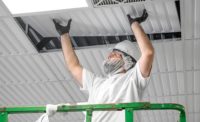Expanded polystyrene has changed the way professionals build since the 1930s. During this time, a German company was searching for a replacement for heavy, expensive die-cast zinc and realized that polystyrene was the ticket to a lighter, more economical construction material. Today, EPS continues to garner a reputation as a leading insulator across a variety of applications, such as homes, businesses, cold storage and more. Contractors and architects further rely on EPS for high-impact projects, from foundations and floors to roofs and soaring bridges and everything in between.
For the wall contractor, EPS rigid foam insulation is a smart solution for exterior, interior and cavity walls, as well as continuous insulation sheathing.
When manufacturers expand polystyrene pellets with steam to make EPS, the result is a lightweight, customizable insulation that affords non-degenerative thermal properties and moisture resistance – in short, it’s the answer to every wall builders’ dreams.
EPS’ physical properties nail cost-effectiveness
Lightweight
Along with polystyrene resin, EPS is composed of 98 percent air. This means that the foam wall boards are extremely lightweight and simple to handle. Fore example, construction crews can easily place EPS insulation exactly where it’s needed for a long-lasting product that doesn’t settle. And with labor freed up on the job site, contractors can save crucial time and money.
Customizable
What’s more, the material is completely customizable either in the factory or field. Builders indicate the precise lengths and widths required for sheathing, walls, systems or underlayment, and the manufacturer delivers. A tailor-made solution like EPS can significantly help with installation labor savings, while sustainably cutting job site waste.
EPS’ customization and lightweight benefits combine with offerings such as “fanfold” panel bundles for interior and exterior walls, crawl spaces and siding underlayment. With this option, picture individual 2 feet by 4 feet panels with a polymeric laminate facer on either side, joined together edge-to-edge and folded up to resemble a foam accordion. Available in 100 and 200 square foot bundles, thicknesses range from 3/8 to 3/4 inch, and wall contractors can customize density.
In application, the average crew member can carry about 400 total square feet (or 200 square feet of EPS per arm) of folded insulation panels. Rather than having to go back and forth holding individual panels, few are needed to lift, maneuver and fasten the fanfold wall insulation. During installation, the true magic happens, as products like these quickly unfold to over a hundred square feet, reducing the number of skilled workers needed and simplifying the overall process.
EPS: The Framework for High-Performance
Thermal properties
R-value is another metric to consider when determining the best insulation for the job. Contractors all know that generally speaking, the higher the R-value, the better the product is at resisting the flow of heat or cold. Or, put another way, high values indicate how much thermal resistance the material has. That being said, it’s also important to note whether that value will stand the test of time.
EPS’ composition, for one, paves the way for long-term R-values and better building envelopes. The rigid foam largely consists of air, which doesn’t leech out of the cellular structure over time. As the EPS Industry Alliance (EPS-IA) summarizes, EPS’ “insulation performance remains stable over its entire life.” This stability means the product doesn’t need to be adjusted for age, a key environmental attribute. It’s also commonplace for EPS manufacturers to warranty their R-values for 20 years, guaranteeing the building envelope component’s performance well into the future.
Moisture resistance
EPS can further protect the building envelope from water damage thanks to its physical properties. As moisture attempts to seep into walls, the insulation’s closed-cell structure gets to work. EPS doesn’t readily absorb water from the atmosphere.¹ And with the addition of vapor and moisture barriers in extreme cases, EPS can safeguard the building envelope from the ongoing threat of water vapor and compromised R-values.
For example, in frigid Fairbanks, Alaska, managers used EPS wall insulation with advanced polymeric laminate facers on army housing units to help withstand long, cold winter nights. Not only did the solution keep condensation from destroying the inside of homes, but the wall system was also able to handle increased moisture from constantly running heaters and HVAC systems.
EPS covers codes and standards
Aside from functionality, specifiers also need to ensure their wall insulation complies with building codes. Fortunately, EPS meets or exceeds the comprehensive strength, flexural strength, dimensional stability and water absorption requirements of ASTM C578, Standard Specification for Rigid, Cellular Polystyrene Thermal Insulation. And for builders who are searching for solutions that can check off ci energy standards, EPS again fits the bill.
ASHRAE 90.1, Energy Standard for Buildings Except Low-Rise Residential Buildings defines ci as “Insulation that is continuous across all structural members without thermal bridges other than fasteners and service openings.” Rigid foam insulations, such as EPS, are ideal for layering over studs and cavities to prevent hot or cold air from escaping. Since 2012, the International Energy Conservation Code has required ci in building envelopes in most Climate Zones both commercially and residentially, and builders are increasingly choosing EPS to adhere to strict energy efficiency standards for green design.
For instance, during an Arizona residential retrofit, the project team incorporated EPS into the home’s wall assembly. Tasked with turning an abandoned 1951 residence into a sustainable, state-of-the-art house that could achieve a Gold rating under the Phoenix Green Construction Code, EPS provided the necessary ci to meet this high rating and offer tangible environmental advantages. The large wall panels reduced air infiltration, moisture penetration and thermal bridging, while increasing insulation to reach energy goals.
Beyond Arizona, EPS is a code-compliant, global solution where cost-effectiveness meets performance for the highest R-value per dollar. When projects call for a superior air- and moisture-resistant building envelope without breaking the bank, bring EPS to a frame near you.













